Monterrey, Nuevo León 作者: 来源: 发布时间:2021-05-27
1.Population and Area
Pop.: 4,295,000 (metro)
Area: 324.8 km2
Elev.: 540 masl
Monterrey location in Mexico within the state of Nuevo León
https://goo.gl/maps/CAdWdNkBqaLjYQ9W8
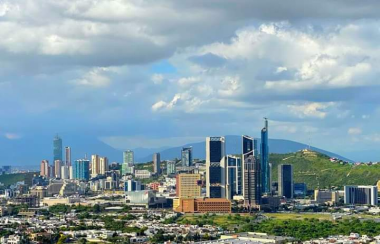
2. Natural geography
The city of Monterrey is 540 metres (1,770 ft) above sea level in the northeastern state of Nuevo León.[28] Monterrey translated from Spanish to English is "King Mount" or "King mountain", which refers to the city's topography and the large mountains that surround it. The Santa Catarina River—dry most of the year on the surface but with flowing underground water—bisects Monterrey from east to west, separating the city into north and south halves, and drains the city to the San Juan River and Rio Grande.
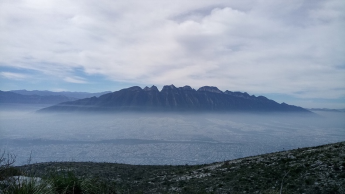
Monterrey is adjacent to San Nicolás de los Garza, García and General Escobedo to the north; Guadalupe, Juárez and Cadereyta Jiménez to the east; Santiago to the south; and San Pedro Garza García and Santa Catarina to the west. Their combined metropolitan population is over 4,080,329 people.
Monterrey lies north of the foothills of the Sierra Madre Oriental mountain range. A small hill, the Cerro del Topo, and the smaller Topo Chico are in the suburbs of San Nicolás de los Garza and Escobedo. West of the city rises the Cerro de las Mitras (Mountain of the Mitres), which resemble the profile of several bishops with their mitres.
Cerro de la Silla (Saddle Mountain) dominates the view at the east of the city and is considered a major symbol of the city. Cerro de la Loma Larga—South of the Santa Catarina river—separates Monterrey from the suburb of San Pedro Garza García. At the summit of the Cerro del Obispado, north of the river, is the historic Bishopric Palace, site of one of the most important battles of the Mexican–American War.
Weather
Köppen Classification: Mid-Latitude Steppe and Desert Climate
This climate type is characterized by extremely variable temperature conditions, with annual means decreasing and annual ranges increasing poleward, and relatively little precipitation. This climate is typically located deep within the interiors of continents and is contiguous with the tropical desert climates of North and South America and of central Asia. This region type owes its origins to locations deep within continental interiors, far from the windward coasts and sources of moist, maritime air. Remoteness from sources of water vapor is enhanced in some regions by mountain barriers upwind.
The Köppen Climate Classification subtype for this climate is "Bsh". (Mid-Latitude Steppe and Desert Climate).
The average temperature for the year in Monterrey is 72.1°F (22.3°C). The warmest month, on average, is July with an average temperature of 83.5°F (28.6°C). The coolest month on average is January, with an average temperature of 57.9°F (14.4°C).
The highest recorded temperature in Monterrey is 118.4°F (48°C), which was recorded in April. The lowest recorded temperature in Monterrey is 32.0°F (0°C), which was recorded in January.
The average amount of precipitation for the year in Monterrey is 23.3" (591.8 mm). The month with the most precipitation on average is September with 5.9" (149.9 mm) of precipitation. The month with the least precipitation on average is January with an average of 0.6" (15.2 mm). There are an average of 73.0 days of precipitation, with the most precipitation occurring in January with 8.0 days and the least precipitation occurring in March with 5.0 days.
In terms of liquid precipitation, there are an average of 59.7 days of rain, with the most rain occurring in September with 8.2 days of rain, and the least rain occurring in March with 3.4 days of rain.
https://www.weatherbase.com/weather/weather-summary.php3?s=49367&cityname=Monterrey%2C+Nuevo+Leon%2C+Mexico&units=

Getting there and around
By Air – You can fly to Monterrey from key US cities and all other main cities in Mexico offer direct flights to and from Monterrey. The airport is about 10 miles north of the city; shuttles and taxis are available to take you into the center of Monterrey. For detailed information about flights and flying, see the Mexperience guide to Air Travel in Mexico.
By Bus – You can travel to Monterrey on a luxury bus from Mexico City – the trip takes around 12 hours. An overnight bus does run from Mexico City to Monterrey, arriving in time to enjoy the day there, although traveling by bus, even on a luxury bus, for 12 hours can be quite tiring. For detailed information about bus transportation read the Mexperience guide to Bus Travel in Mexico.
By Car – Monterrey is well connected by federal (free) and tolled roads, connecting it to the colonial heartland and Mexico City in the south, and the USA in the north. See additional information about Driving in Mexico and Mexico’s Toll Roads on Mexperience.
Car Rental – To explore Mexico independently, consider renting a car for your visit. Having your own car will give you more flexibility than using public transport options and, in some cases, offer you access to places which are otherwise difficult to visit without the use of a car. Read our guide to Car Rental in Mexico to learn what you need to know about car rental in Mexico and connect to the Mexperience Travel Center to reserve your Rental Car.
Taxis – Monterrey’s taxis are metered. Taxi travel is very affordable in Mexico, in comparison to the USA, Canada and Europe, and so provides a viable means of public transportation in Mexico. Your hotel can arrange taxis for you; some post their rates on a board in the lobby; taxi hotel rates are usually higher than cabs you hail off the street. If you speak Spanish, you will have a distinct advantage in your negotiations with local taxi drivers. For detailed information, read the Mexperience guide to Taxi Travel in Mexico.
Metro – A very simple two-line metro system can take you to various places around the city. The over-ground tram (line 1) runs west-east and is designed to transport people from residential areas in the south to the city center; the underground train (line 2) runs north-south and is good for all major attractions in and around the city’s center.
https://www.mexperience.com/travel/big-cities/monterrey/
Uber/Cabify - You can easily request an Uber pickup at Monterrey Mx airport, but there are a couple of things to consider. Uber driver will typically call you to confirm pickup spot, as they cannot pick you up at the taxi/shuttle curb. Also, they will ask you to act casual as they can be stopped/fined by federal authorities at the airport. Some usual practices are for the driver to get out of the car, shake your hand, help you with the luggage. It is recommended for you to ride at passenger seat, not back seat. With that you will be perfectly fine!
Reason behind is because any taxi transportation FROM the airport is only permitted for airport taxi companies. This is a federal regulation from long ago and agreed with the taxi drivers union (will not change any time soon). Airport property is a federal property and thus this regulation is enforced by federal police. However, since Uber cars are not required to display any Uber signs, with the recommendations above you will be perfectly fine, as technically you are just being picked up by a friend/acquaintance. Yes, kind of a don't ask-don't tell approach, but has been the only work around for now for Uber pick-ups at Monterrey airport.
Drop-offs at airport are perfectly fine with any taxi company, the mentioned regulation only applies for airport pick-ups.
https://www.tripadvisor.com/ShowTopic-g150782-i603-k10317572-Uber_from_the_airport_to_downtown_Uber_desde_el_aeropuerto-Monterrey_Northern_Mexico.html
3.GDP
GDP: 78.5 B USD
4. Industry
Monterrey is a major industrial center in northern Mexico, producing a GDP of 78.5 billion US dollars (2006). The city's GDP per capita in 2010 was 607,042 Mexican pesos or $46,634 US dollars. The city was rated by Fortune magazine in 1999 as the best city in Latin America for business and is currently ranked third best by the América Economía magazine.
The city has prominent positions in sectors such as steel, cement, glass, auto parts, and brewing. The city's economic wealth has been attributed in part to its proximity to the United States-Mexico border and economic links to the United States.
Industrialization was accelerated in the mid-19th century by the Compañia Fundidora de Fierro y Acero Monterrey, a steel-processing company. Today, Monterrey is home to transnational conglomerates such as Cemex (the world's third largest cement company), FEMSA (Coca-Cola Latin America, largest independent Coca-Cola bottler in the world), Alfa (petrochemicals, food, telecommunications and auto parts), Axtel (telecommunications), Vitro (glass), Selther (leading mattress and rest systems firm in Latin America), Gruma (food), and Banorte (financial services). The FEMSA corporation owned a large brewery, the Cuauhtémoc Moctezuma Brewery (Cervecería Cuauhtémoc Moctezuma) that produces the brands Sol, Tecate, Indio, Dos Equis and Carta Blanca among others, in the beginning of the year Cuauhtémoc Moctezuma Brewery was sold to Dutch-based company Heineken. By the end of the same year, there were more than 13,000 manufacturing companies, 55,000 retail stores, and more than 52,000 service firms in Monterrey.
The metals sector, dominated by iron and steel, accounted for 6 percent of manufacturing GNP in 1994. Mexico's steel industry is centered in Monterrey, where the country's first steel mills opened in 1903. Steel processing plants in Monterrey, privatized in 1986, accounted for about half of Mexico's total steel output in the early 1990s.
Monterrey was ranked 94th worldwide and fifth in Latin America in terms of Quality of Life according to Mercer Human Resource Consulting (2006), and was ranked second in 2005 and fourth in 2006, according to América Economía.
Some of the shopping malls in the city include Paseo San Pedro, Paseo La Fe, Plaza Fiesta San Agustín, Galerías Monterrey, and Galerías Valle Oriente, which distribute goods and services to the Mexican population.
5. Touristic sites
Macroplaza
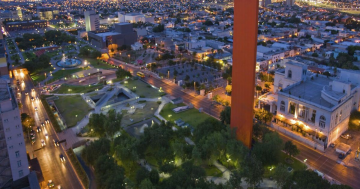
The Macroplaza is the fifth-largest plaza in the world and the largest Plaza in Mexico. It has an extension of 400,000 square metres consisting of various monuments, smaller plazas and gardens.
The Macroplaza was built in the early 1980s during the governorship of Alfonso Martínez Domínguez. The construction of the Macroplaza required the demolition of several old buildings and houses including a famous movie theater.
One of the most iconic monuments of the city is the Faro del Comercio (Lighthouse of Commerce), a 70-meter-tall modern lighthouse located in the same plaza, equipped with a green laser, that shot its light around the city at nights.
Sometimes referred to as the Makro Plaza, when you come here, you’ll see why. Life in the plaza is packed full with energy and its size makes it one of the largest plazas in the world. It would overwhelm you were it not for the buildings, walkways and fountains that have been built-in to this focus-piece of the city’s central area.
The Plaza is host to many of the city’s most important buildings: the cathedral, the Palacio de Gobierno (Government Palace); the Museo de Arte Contemporaneo, the Palacio Municipal (Municipal Building), the Main Post Office, and the Palacio de la Justicia (Court House) to name a few.
Barrio Antiguo
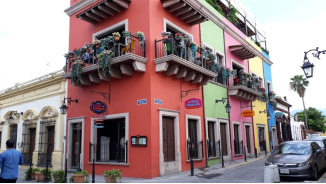
Popularly known as the Barrio Antiguo (Spanish old quarter) comprise what is preserved from the historical quarter of the city of Monterrey, Nuevo León, Mexico. Currently located next to the Government Palace and the Macroplaza, it originally covered a larger space from the Santa Catarina River to 5 de Mayo Street, south to north, and from Mina Street to Roble Street (nowadays Avenida Benito Juárez), east to west. Most of the buildings now preserved are from the Spanish Colonial period and from the last years of the 19th century.
Archaeologically speaking, the oldest Monterrey dates from the very founding of the city at the end of the sixteenth century. However, the buildings preserved today date mostly from the eighteenth century onwards. It used to be the commercial and cultural center of the city during the existence of the Viceroyalty of New Spain until recently the first half of the 20th century, when other parts of the city began to grow more to the detriment of the center. During the last decades of the 20th century there was a modern lifestyle in the Barrio Antiguo, characterized by the construction of hotels, museums, bars, discos and restaurants of international cuisine. Thus until depopulation and partial abandonment tended to decline from the 1990s to recent times, as currently there are projects under way for its restoration. Many houses of what used to be the Barrio Antiguo were demolished to give way to the construction of the Macroplaza (lit. big square) at the end of the past century. During the last decade of the twentieth century and recent years, Barrio Antiguo was well known as the center of the nightlife of Monterrey due to measures taken by the State in a failed attempt to create reforms that pushed the re-activation of the urban center.
https://www.inspirock.com/mexico/monterrey/barrio-antiguo-a37003857
Parque Fundidora
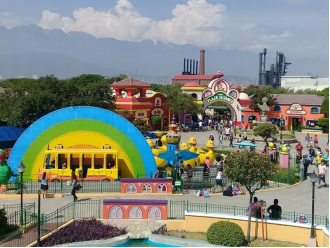
Situated in the heart of Monterrey, Parque Fundidora offers visitors 140 hectares (345 acres) of recreation space. The park occupies the former site of the bankrupted Monterrey Foundry--several old foundry buildings, including the blast furnace and chimney, remain on the grounds. Jog, cycle, or skate around the park, have a picnic next to the artificial lake, or take the kids to the Sesame Street-themed park. Numerous pedestrian walkways allow you to take relaxing strolls, while the ice rink, sports arena, and the arts center provide entertainment.
https://www.inspirock.com/mexico/monterrey/parque-fundidora-a37006517
Ride to the top of Horno3
Horno3 (or Museo del Acero Horno3 to give it its full title) is located in Parque Fundidora and is a striking edifice which has been turned into a museum that pays homage to Mexican industry. Once part of the Monterrey steel industry that was located in this park, Horno3 is one of Mexico’s largest museums. Take a trip in the lift which leaves you on the viewing platform and enjoy the breeze and the view.
https://theculturetrip.com/north-america/mexico/articles/the-top-14-things-to-see-and-do-in-monterrey
Grutas de García
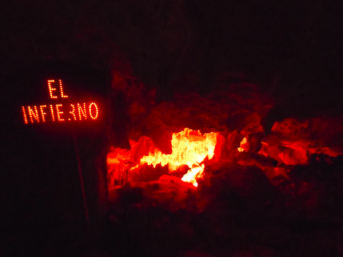
For a day trip outside the centre, Las Grutas de García also make a great choice. Easily accessible via public transport, ticket vendors are always fotted about La Alameda. Once there, the tour itself lasts about 40 minutes, and shows you around some of the notable stalagmite and stalactite structures in the caves. Some of them bear little more than a passing resemblance to their supposed appearance, but it’s an enjoyable day out all the same. A cable car transports visitors to and from the grutas (caves), but if you really want, you can walk back down to the bottom.
https://theculturetrip.com/north-america/mexico/articles/the-top-14-things-to-see-and-do-in-monterrey
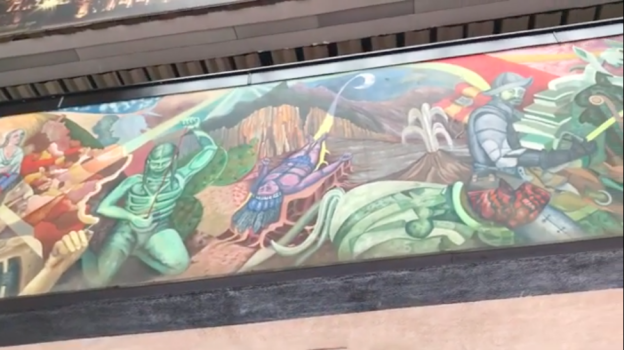
MEXICO'S MOST BEAUTIFUL CITY! What to do in Monterrey
https://youtu.be/pGTkjIJx6vk
6. History and Culture
Prehispanic history
Before the European foundation of the city, there was no established nation-state, and the population consisted of some indigenous semi-nomadic groups. Carved stone and cave painting in surrounding mountains and caves have allowed historians to identify four major groups in present-day Monterrey: Azalapas, Huachichiles, Coahuiltecos and Borrados.
Foundation
In the 16th century, the valley in which Monterrey sits was known as the Extremadura Valley, an area largely unexplored by the Spanish colonizers. The first expeditions and colonization attempts were led by conquistador Alberto del Canto, who named the city Santa Lucia, but they were unsuccessful because the Spanish were attacked by the natives and fled. The Spanish expeditionary Luis Carvajal y de la Cueva negotiated with King Philip II of Spain to establish a territory in northern New Spain that would be called Nuevo León, the "New Kingdom of León". In 1580 he arrived in the newly granted lands but it was not until 1582 that he established a settlement called San Luis Rey de Francia (named for Saint Louis IX of France) within present-day Monterrey. The New Kingdom of León extended westward from the port of Tampico to the limits of Nueva Vizcaya ("New Biscay", now State of Chihuahua), and around 1,000 kilometers northward. For eight years Nuevo León was abandoned and uninhabited, until a third expedition of 13 families led by conquistador Diego de Montemayor founded Ciudad Metropolitana de Nuestra Señora de Monterrey ("Metropolitan City of Our Lady of Monterrey") on September 20, 1596, next to a water spring called Ojos de Agua de Santa Lucia, where the Museum of Mexican History and Santa Lucía riverwalk are now. The new city's name was chosen to honor the wife of Gaspar de Zúñiga, 5th Count of Monterrey, ninth Viceroy of New Spain.
Monterrey's Coat of Arms shows an Indian throwing an arrow to the sun in front of Cerro de la Silla mountain. This represents a native ceremony performed at sunrise.
During the years of Spanish rule, Monterrey remained a small city, and its population varied from a few hundred to only dozens. The city facilitated trade between San Antonio (now in Texas), Tampico and from Saltillo to the center of the country. Tampico's port brought many products from Europe, while Saltillo concentrated the Northern Territories' trade with the capital, Mexico City. San Antonio was the key trade point with the northern foreign colonies (British and French).
After Mexican Independence (19th century)
In the 19th century, after the Mexican Independence War, Monterrey rose as a key economic center for the newly formed nation, especially due to its balanced ties between Europe (with its connections to Tampico), the United States (with its connections to San Antonio), and the capital (through Saltillo). In 1824, the "New Kingdom of León" became the State of Nuevo León, and Monterrey was selected as its capital. But the political instability that followed the first 50 years of the new country allowed two American invasions and an internal secession war, during which the governor of the state annexed Coahuila and Tamaulipas states, designating Monterrey as the capital of the Republic of the Sierra Madre as it did before in 1840 for the Republic of the Rio Grande.
In 1846, the earliest large-scale engagement of the Mexican–American War took place in the city, known as the Battle of Monterrey. Mexican forces were forced to surrender but only after successfully repelling U.S. forces' first few advances on the city. The battle inflicted high casualties on both sides, much of them resulting from hand-to-hand combat within the walls of the city center.
Many of the generals in the Mexican War against France were natives of the city, including Mariano Escobedo, Juan Zuazua (b. Lampazos de Naranjo, NL) and Jerónimo Treviño.
Contemporary history
During the last decade of the 19th century, Monterrey was linked by railroad, which benefitted industry. It was during this period that José Eleuterio González founded the University Hospital, now one of northeast Mexico's best public hospitals, affiliated with the School of Medicine of the Autonomous University of Nuevo León (UANL). Antonio Basagoiti and other citizens founded the Fundidora de Fierro y Acero de Monterrey. The brewery Cervecería Cuauthemoc, one of the milestone local enterprises, was founded in 1890. A steel-producing company that accelerated the already fast industrialization of the city was founded in 1900 and became one of the world's biggest. In 1986, Monterrey hosted several games of the 1986 FIFA World Cup.
In 1988, Hurricane Gilbert caused great damage to the city; the Santa Catarina River overflowed, causing about 100 deaths and economic damage.
The city has hosted international events such as the 2002 United Nations Conference on Financing for Development with the participation of more than 50 heads of state and government, as well as other ministers and senior delegates from over 150 countries. The conference resulted in the adoption of the Monterrey Consensus, which has become a reference point for international development and cooperation. In 2004, the OAS Special Summit of the Americas was attended by almost all the presidents of the Americas
In 2007, Monterrey held the Universal Forum of Cultures, with four million visitors. In 2008, Monterrey held the FINA World Junior Championships.
In 2010, Monterrey was hit by another damaging storm, Hurricane Alex. Alex was considered worse than Hurricane Gilbert, with record-breaking rain bringing floods and causing severe economic damage. Damage estimates totaled US$1.885 billion and $16.9 billion MXN. Reconstruction and urban renewal ensued. Recently, the Nuevo León Development Plan 2030 was presented, along with some other metropolitan projects.
In August 2011 the city was the scene of a terror attack on a casino, in which more than 50 people were killed.
7. Contact Information
City Mayor: Adrián de la Garza

Contact number: +52 (81) 8130 6565
Govt. Office Address: Zaragoza y Ocampo S/N, Zona Centro Monterrey, N.L., C.P. 64000
Twitter: https://twitter.com/AdrianDeLaGarza
FB: https://www.facebook.com/AdrianDeLaGarzaS
Website: http://www.monterrey.gob.mx/oficial
